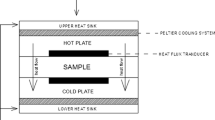Abstract
Heat insulation mats based on water glass bonded non-textile flax and hemp fibres were fabricated via a pilot plant, and their heat conductivities investigated. Under the influence of various factors like moisture content, water sorption and diffusion processes, fibre characteristics and heat radiation as well as thickness and apparent density, heat conductivities in the range of 0.0392–0.0484 W/mK for flax fibre mats and 0.0441–0.0592 W/mK for hemp fibre mats were obtained. Strong interactions between the fibre characteristics on the one hand and the water sorption and diffusion processes, the heat radiation, the apparent density and the thickness on the other hand were found. Investigations of tensile strengths and dimension stabilities indicate that the isolation mats are easy to handle and a structural alteration of an overall construction will not occur.
Zusammenfassung
Wärme-Dämmstoffmatten, basierend auf wasserglasgebundenen, nichttextilen Flachs- und Hanffasern, wurden über eine Technikumanlage hergestellt und deren Wärmeleitfähigkeiten untersucht. Unter dem Einfluss verschiedener Faktoren wie Feuchtegehalt, Wassersorptions- und Diffusionsprozesse, Fasereigenschaften und Wärmestrahlung sowie Dicke und Rohdichte wurden Wärmeleitfähigkeiten im Bereich von 0.0392–0.0484 W/mK für Flachsfasermatten und 0.0441–0.0592 W/mK für Hanffasermatten erhalten. Es wurden starke Wechselwirkungen zwischen den Fasereigenschaften auf der einen Seite und den Wassersorptions- und Diffusionsprozessen, der Wärmestrahlung, der Rohdichte und der Dicke andererseits gefunden. Untersuchungen der Zugfestigkeit und Formbeständigkeit zeigen, dass die Isolationsmatten einfach zu handhaben sind und eine bauliche Veränderung einer Gesamtkonstruktion nicht auftreten wird.



Similar content being viewed by others
References
Bobeth W (1993) Verhalten bei Feuchte- bzw. Wassereinwirkung. In: Bobeth W (ed) Textile Faserstoffe. Springer, Berlin Heidelberg New York, p 231–252
Caps R, Umbach K-H (1990) Optimierung der Wärmeisolation von Polyester-Vliesstoffen. Melliander Textilberichte 6:440–445
DIN 18165-1 (1991) Faserdämmstoffe für das Bauwesen—Teil 1. Beuth, Berlin
DIN 52612 (1979) Wärmeschutztechnische Prüfungen; Bestimmung der Wärmeleitfähigkeit mit dem Plattengerät, Durchführung und Auswertung. Beuth, Berlin
DIN 52620 (1991) Bestimmung des Bezugsfeuchtegehalts von Baustoffen. Beuth, Berlin
DIN 68755 (2000) Holzfaserdämmstoffe für das Bauwesen—Teil 1: Dämmstoffe für die Wärmedämmung. Beuth, Berlin
DIN EN 1602 (1997) Wärmedämmstoffe für das Bauwesen—Bestimmung der Rohdichte. Beuth, Berlin
DIN EN 1608 (1997) Wärmedämmstoffe für das Bauwesen—Bestimmung der Zugfestigkeit in Plattenebene. Beuth, Berlin
Hell F (1982) Grundlagen der Wärmeübertragung. VDI-Verlag, Düsseldorf
Kisseloff P (1969) Feuchtigkeitsbewegung und Wärmeleitung in Holz. Holz Roh-Werkstoff 27:245–253
Koch PA (1955) Faserstoffe. In: Landoldt-Börnstein (ed) Zahlenwerte und Funktionen aus Physik, Chemie, Astronomie, Geophysik, Technik, 6th edn. Bd. IV/1. Springer, Berlin Heidelberg New York
Kollmann F, Malmquist L (1956) Über die Wärmeleitzahl von Holz und Holzwerkstoffen. Holz Roh-Werkstoff 14:201–204
Kozlowski R (2000) Potential and diversified uses of green fibres. 3rd Int. Wood and Natural Fibre Composites Symposium, 19–20 Sep. 2000, Kassel, Germany, pp 2-1–2-14
Kymäläinen H-R, Hautala M, Kuisma R, Pasila A (2001) Capillarity of flax/linseed (Linum usitatissimum L.) and fibre hemp (Cannabis sativa L.) straw fractions. Ind Crops Prod 14:41–50
Martin JP, Lamb GER (1987) Measurement of thermal conductivity of non-wovens using a dynamic method. Text Res J 57:721–727
Richter Ch, Scheiding W (1995) Neue Moeglichkeiten zur Herstellung von Daemmstoffen und Verpackungskoerpern aus Duennholz und Holzresten. Holz-Zentralblatt 2/3:15–19
Schardt G, Mägel M, Gulich B (1993) Untersuchung zum Wärmeisolationsverhalten von Nadelvliesstoffen. Techn Textilien 36:T114–T119
Scheiding W (2000) Thermal conductivity of wood fibers for insulation panels. Holz Roh-Werkstoff 58:177–181
Scheiding W (2001) Waterglass as adhesive for insulation material. Holz Roh-Werkstoff 59:327–333
Acknowledgements
The author like to thank S. Malstädt (Fachhochschule Pirmasens, Pirmasens, Germany) and M. Theis (AgroSys GmbH & Co. KG, Bad Sobernheim, Germany) for helping in insulation mat fabrication as well as O. Rechenbach and Dr. H. Heinrich (Universität Kaiserslautern, Kaiserslautern, Germany) for the heat conductivity measurements and helpful discussions. Sincere thanks are given to Dr. T. Stumm and Dr. P. Schäfer (Fachhochschule Pirmasens, Pirmasens, Germany) for their beneficial discussions and valuable ideas. H. Hoffmann and P. Forster (FIW—München, München, Germany) are gratefully acknowledged for measuring heat conductivities and the other related properties. Sincere thanks are also given to G. Glaßer (Max-Planck-Institut für Polymerforschung) for SEM micrographs. The Landesministerium für Wirtschaft, Verkehr, Landwirtschaft und Weinbau Rheinland Pfalz granted this research.
Author information
Authors and Affiliations
Corresponding author
Rights and permissions
About this article
Cite this article
Grohe, B. Heat conductivities of insulation mats based on water glass bonded non-textile hemp or flax fibres. Holz Roh Werkst 62, 352–357 (2004). https://doi.org/10.1007/s00107-004-0487-9
Published:
Issue Date:
DOI: https://doi.org/10.1007/s00107-004-0487-9




